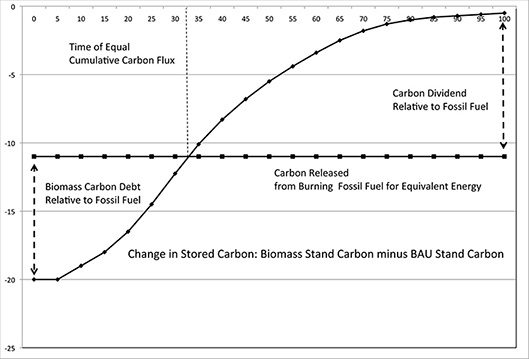
The view of the life cycle in the study is based on a process that starts with a carbon debt (combusting biomass or fossil fuel emits GHGs), progresses through carbon recovery (the sequestration of carbon by forests) to a period after the carbon debt is paid and carbon dividends begin to accrue.
This process can most clearly be seen in the Figure 1, which appears in the study on page 6. The graph represents a hypothetical example developed solely to demonstrate the process for understanding the life cycle carbon emissions of biomass compared to fossil fuels.

Figure 1 (tonnes of carbon). The schematic above represents the incremental carbon storage over time of a stand harvested for biomass energy wood relative to a typically harvested stand (BAU--Business as Usual). The initial carbon debt (9 tonnes) is shown as the difference between the total carbon harvested for biomass (20 tonnes) and the carbon released by fossil fuel burning (11 tonnes) that produces an equivalent amount of energy. The carbon dividend is defined in the graph as the portion of the fossil fuel emissions (11 tonnes) that are offset by forest growth at a particular point in time. In the example, after the 9 tonnes biomass carbon debt is recovered by forest growth (year 32), atmospheric GHG levels fall below what they would have been had an equivalent amount of energy been generated from fossil fuels. This is the point at which the benefits of burning biomass begin to accrue, rising over time as the forest sequesters greater amounts of carbon relative to the typical harvest.
The starting points of this graph represent the amount of carbon released by burning fossil fuel (an average rate for oil, coal and natural gas of 11 tonnes) and the amount of tree stand carbon that is removed when the woody material removed is to be burned (20 tonnes). The carbon debt of biomass—defined as both logging slash and whole trees in the study—is the difference between these two—it emits 9 tonnes more carbon than fossil fuels would have to create the same amount of energy. As the rest of the stand continues to grow and sequester carbon, that debt is eventually repaid (in year 32), and from that point on, the stand continues to grow, sequester carbon, and produces an ongoing carbon dividend. In essence, it begins sequestering carbon emitted from other processes.
Using this type of carbon debts and dividends analysis, the Center estimates the year at which carbon dividends begin to accrue if biomass replaces other energy sources by technology: 5 years if biomass replaces oil in a CHP or thermal facility, 21 years if biomass replaces coal in an electricity plant, 24 years if biomass replaces natural gas in a thermal facility, and 90 years if biomass replaces natural gas at an electricity generating facility.
The entire study can be found here.


 Suz-Anne Kinney
Suz-Anne Kinney


